Bust or portrait coinage
The bust of the monarch (then Philip V) can be found on gold coins (1, 2, 4 and 8 escudos) from 1732 but the change for silver coins was more complicated to implement. On 19 September 1759[text needed] Charles III resolved that all silver coins would be engraved with the king’s bust. The Mexican Mint sent samples that were approved in Madrid on 13 May 1761, but it would not be reflected in the traditional circulation until ten years later.
During the reign of Charles III (1759-1788) major coinage design changes were introduced in order to unify the various coinage types of Spain’s provincial mints. On 18 March 1771 a Royal Decree was issued in Pardo, Spain, to standardize the issues of Spain with those of the Americas and reduce its fineness (from 0.917 to 0.903).
King Charles III assigned this task to Spanish medalist, painter, and line-engraver Tomas Francisco Prieto. The position of Superintendent to all the mints of the kingdom was bestowed upon Prieto with the intent of improving and unifying the coinage types within the Spanish empire. Although some mints were producing similar coinage at this time, this was not the case with all mints. For example in 1771 the mint of Potosi, Bolivia was producing the milled pillar coinage as well as the irregular hand hammered cob coinage.
Essentially, Prieto came up with two standard designs; one for the various gold denominations, and a second design for the corresponding denominations in silver. The design for the gold coinage featured the cuirassed portrait of Charles III wearing drapery with a long collar, armor, and the order of the Golden Fleece facing right. The reverse bore the Spanish coat of arms encircled by the order of the Golden Fleece.
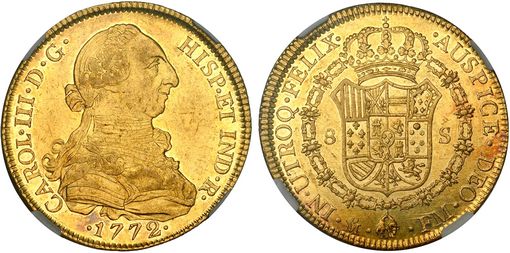
8 Escudos dated 1772 of the new design by Prieto
The silver denominations, although similar, had subtle yet distinct differences. The portrait of Charles III is depicted wearing a laurel wreath in his hair and the drapery is more pronounced. However, the silver issues lacked the long collar and order of the Golden Fleece. The reverse of the silver issues bears the arms of Castile & Leon with the Pillars of Hercules at either side. The most plausible reason for these two distinct types was to prevent contemporary plating of the silver pieces to pass off in circulation as a gold coin.
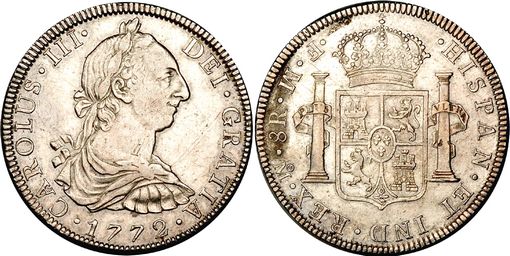
8 Reales dated 1772 of the new design by Prieto
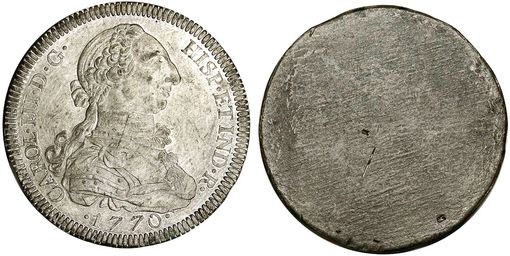
Cf. KM-156.1 Uniface sample or trial strike of the obverse of an 8 Escudos struck in pewter dated 1770 (Stack’s Bowers Baltimore Auction, November 2010, lot 6544).
Full denomination sets of these samples/patterns/trial strikes were shipped from Spain to the colonial mints in the New World
as samples of the new intended coinage.
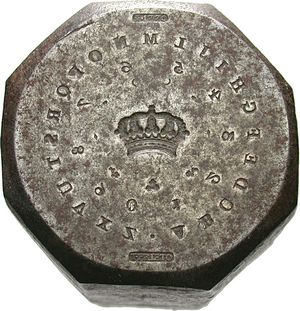
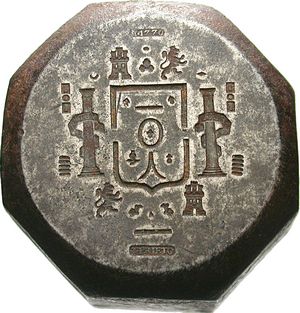
Two master dies both signed by Prieto at 6 o’clock with an incuse punch bearing his name “T. PRIETO”.
A second punch is present at 12 o’clock that bears the Madrid mint mark with a date of 1770.
These were shipped from Spain to the new world mints along with the samples/patterns/trial strikes in pewter
Upon completion of the new coinage designs, uniface obverse and reverse strikings in pewter along with master dies and hubs were shipped to the colonial mints in Mexico City, Potosi in Bolivia, Santiago in Chile, Bogota and Popayan in Colombia, Guatemala, and Lima in Peru. Although these uniface pewter patterns were shipped to all of the colonial mints, it is impossible to determine which patterns were sent to which mints. The reverse of these uniface pewter strikes are without an identifying mint or assayer’s mark that would identify them as being specific to any one mint. Essentially, these uniface pewter strikes served as samples for the provincial mints almost to reference what the new coinage was intended to look like. The above pictures of master dies are quite interesting as well. Master dies like this were shipped to the colonial mints to be used to create punches for the purpose of creating a die. Basic design elements as well as numerals and letters for the legends are arranged in the face of each master die. Soft steel (prior to being hardened) would be worked into these areas, then hardened as a punch to be used later for sinking a die. Similar master dies were sent bearing the newly designed portraiture of the king and were used for making punches in a similar manner. No doubt master dies like these created countless punches for the purpose of die sinking and were probably still in use well into the reign of Ferdinand VII.
A document dated 9 June 1771 mentions that three boxes with various tooling were sent from Spain for the beginning of the manufacture of the new Bust coinage. The first box contained stuff relating to the gold Escudos. The second box related to the silver coinage and contained four matrices for the obverse of each of the five values, and three matrices for each reverse as well as dies and punches. The third box contained dies, punches and specimensEn el primer cajón lo relacionado a las suertes de oro (Escudos). En el segundo cajon, lo relacionado a las acuñaciones en plata, destacando: para el anverso 4 matrices de retrato para cada uno de los valores, 8, 4, 2, 1, 1/2 Real. Mientras que para el reverso 3 matrices de retrato para cada uno de los valores. Cuatro troqueles en liso, una cubeta de hoja de lata con un ponzón de retrato correspondiente al real de a Ocho de Plata, concluido, templado y probado, otra cubeta con el mismo anterior contenido pero sin templar. Un retrato de bronce vaciado por el modelo de cera original que se modeló para estudio del doblón de a ocho Escudos que se remite en grande para el mejor estudio de los retratos. En el tercer cajón, piezas en liso, troqueles, ocho grandes, siete medianos, ocho punzones grandes, dieciséis medianos, ciento setenta y seis de distintos tamaños para columnas, coronas, castillos, leones, letras, etc. Diez muestras para monedas de plata con cordoncillo. Cuatro muestras de cada lado de las monedas que componen en todas setenta y dos muestras de estaño, para uso de los grabadores Siendo un gran total para las suerte en plata de: 20 matrices de retratos para las clases de plata, 15 matrices de reversos, 15 matrices de coronas y abecedarios, 1 punzón de retrato, concluido, templado y probado para 8 Reales..
On 2 January 1772 the Viceroy Antonio María de Bucareli ordered the silver and gold coin to be engraved according to new seals and matrices, in accordance with the new Royal Ordinance given in El Pardo on 18 March the previous year. On 29 May 1772 Charles III confirmed the disposition of 2 January 1772[text needed]. This Pragmatic, unlike the previous one of 18 March 1771, contained greater detail in terms of the design of the new coin so it is likely that the new coins were minted after May.
So In 1772 there were two totally different 8 Reales, both an (extremely rare) Pillar and a Bust.
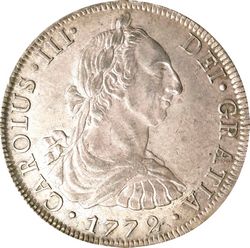
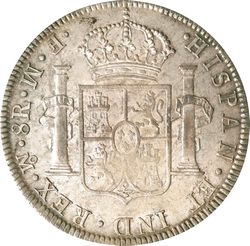
KM-106.1 8r 1772 Mo FM (Stack’s Bowers Auction, 26 August 2022, lot 34164)
This 1772 coin has inverted Assayer's letters and mint mark.
In a document dated 8 March 1774 the Accountant of the Mint, Manuel de Lizara, clarified that 1771 was the last year to make coins of the Pillar type.
There were complications in the manufacture of the new currency. The engravers and carvers of the mint Antonio Cervantes, Luis Gómez, Francisco Casanova, Alejo Bernabe Madero, Juan Fernández de la Peña and Francisco Monllor were unable to adjust and perfect the tooling of the new coin. For this reason, Charles III ordered the improvement in the training of engravers, allocating more personnel and resources to the mint of Mexico, especially its engraving office. Although problems persisted, this was a precedent for the future creation of the San Carlos Academy of Arts.
With the royal order of 21 January 1773, a new set of stamps was sent to the engraver to correct the defects of the first issue.
On 24 February 1773 Viceroy Antonio Maríz Bucareli reported defects in the coins: in a letter of 28 April 1774 the engraver of the Mint added to these comments informing the Superintendent Judge of problems when the Royal Bust was die-cut, the wear of dies, the pooor light in the mint, deficiencies in the flywheel press. Such complications would continue: on 11 December 1787, a report by Francisco Fernández de Cordova and Francisco Antonio de la Peña, Treasurer of the Royal Mint, noted "imperfections in the polish and beauty of the coin".
Between 1772 and 1783, adaptations were made to the mint building, such as the introduction of new machinery and new spaces.
[image needed]
A scarce 8 Reales was minted with an error in the date (it was recorded as 1872 rather than 1782). This error was noticed at the time and on 11 January an order was made for their recall.
On 25 February 1786, the " very reserved Royal Order " [text needed] was issued, by which the fineness of silver coins was lowered to 10 dineros, 18 grains (0.896) and gold coins to 21 carats (0.875).
In 1792 the General Engraver of the Court detected some defects in the gold and silver coins that were sent from Mexico, so the Superintendent of the Mexican Mint requested that the necessary measures be taken to correct the defects in the future. Again in 1801 a Royal Order was issued that ordered the correction of the defects noted in the engraving of the coin: the Superintendent replied arguing that due to the quantity and speed of the work sometimes the inspection could not be allowed due to lack of time, added to the fact that the shortage of steel forced them to make the stamps last beyond the optimal.
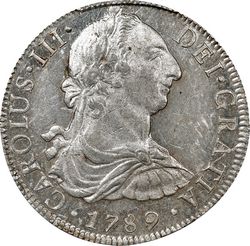
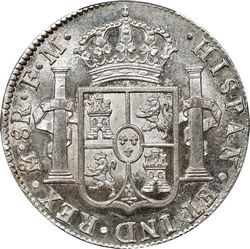
KM 106.2A 8 reales 1789 Mo FM (Stack’s Bowers NYINC Auction, 13 January 2023, lot 21176).
The last year for Charles III.
Charles IV
The amount of coinage for Charles IV is given here.
The coins of 1789 and 1790 bear the bust of Charles III, not his successor Charles IV. In view of the high costs and delays in manufacturing and transporting stamps from Spain to America, an order of 24 December 1788 authorized the addition of one more Roman numeral, thus changing the inscription to read CAROLVS IIII. Coins of this type were struck in Mexico during 1789 and 1790.
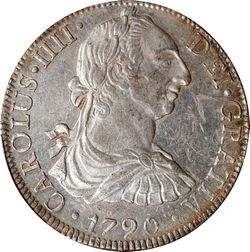

KM 108 8 reales 1790 Mo FM (Stack’s Bowers Auction, 14 November 2022, lot 71720)
The bust of Charles III but legend Charles IIII.
Also, some of the Charles III dies were modified by changing the inscription to read CAROLVS IV, and coins bearing this change are found for the years 1789 and 1790.
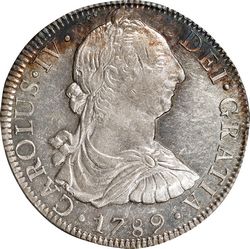

KM 107 8 reales 1789 Mo FM (Stack’s Bowers NYINC Auction, 13 January 2023, lot 21178)
The bust of Charles III but legend for Charles IV.
Ferdinand VII
The mintage during Ferdinand VII's reign is given here.
